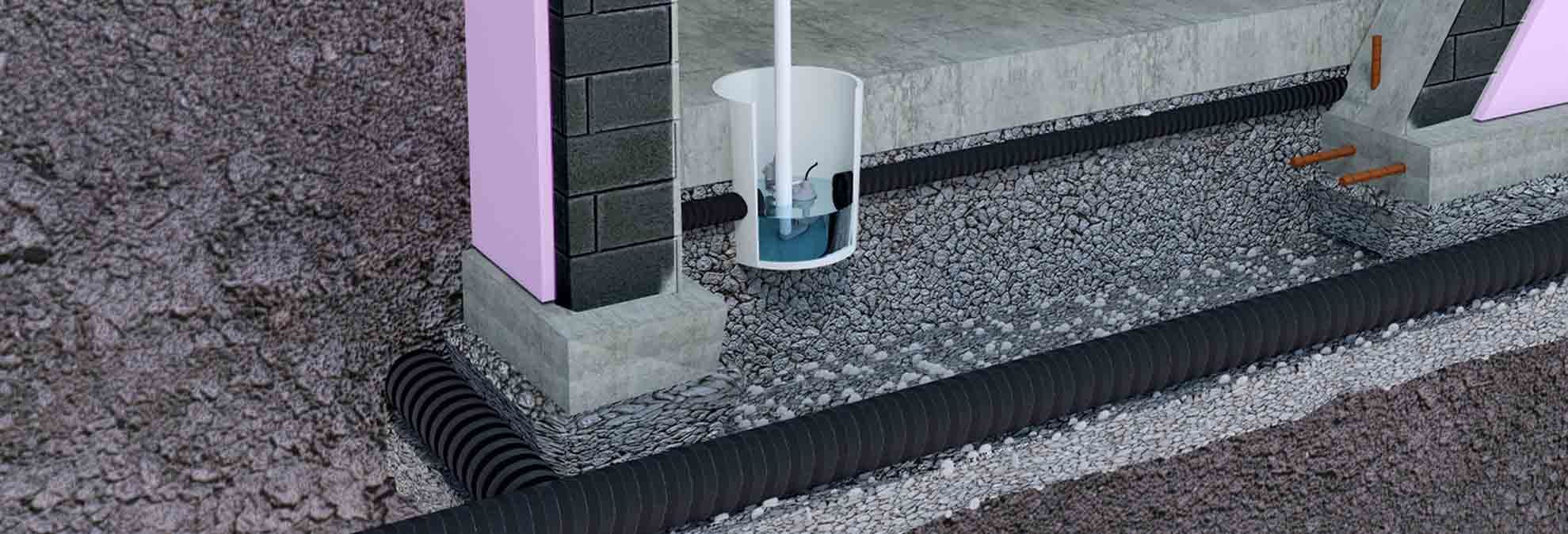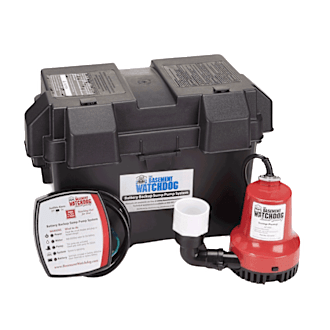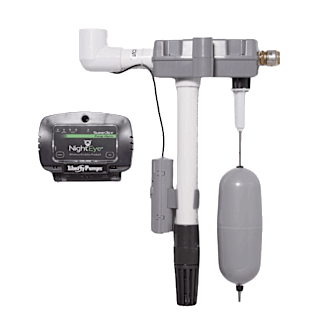
Sump Pump Backup System Buying Guide

When heavy seasonal rains start pooling around your house, the last thing you want is to be humming Johnny Cash’s “Five Feet High and Rising” as water creeps up in your basement.
But that may be the case if your home’s sump pump is disabled by a power failure, a mechanical breakdown, or simply an overwhelming amount of water. That’s why it’s wise to have a backup system installed. These systems act as a fail-safe to keep water damage—and the costly cleanup that follows—at bay when your primary pump stops working.
That failure is often a consequence of a storm-related power loss. According to Climate Central, the number of weather-related power outages from 2014 to 2023 was nearly double the number from 2000 to 2009, making backup units a necessity rather than a luxury.
But weather-related outages aren’t the only reason your sump pump can go down. “Sump pumps can fail for various reasons—not just power outages but also old age or lack of maintenance,” says Dave Jones, a master plumber at Roto-Rooter.
Types of Backup Sump Pump Systems
There are three main types of backup systems available, each with its own advantages and drawbacks, depending on your home’s needs.

Battery-Powered Backup Pumps
Battery-powered backup pumps are the most common backup system, designed to take over when your main pump loses power or stops functioning. These systems typically use a 12-volt deep-cycle battery—the same type used in some trolling boats or golf carts—with costs ranging from $100 to $300 or more. The battery’s capacity, measured in amp-hours (Ah), indicates how long it can power the pump. A battery with 75Ah to 120Ah will allow several hours of intermittent pumping, which can often stretch over several days during an extended blackout. Most models can move 800 to 2,000 gallons per hour (gph) from your sump pit, with higher-gph models better suited for homes prone to significant water influx during storms.
How they work: Battery-powered systems use a float switch to activate the pump when the water level in the sump pit rises. Drawing power from the battery, the pump discharges the water through the same discharge pipe used by your primary sump pump.
Battery life: A fully charged deep-cycle battery typically provides 7 to 8 hours of active pumping time, which roughly translates to several days’ worth of intermittent pumping during a sustained blackout.
Pros
● They generally cost less than combo or water-powered units.
● They can operate for several days on a charge, providing effective coverage for most outages.
● They’re relatively easy to install for DIYers with basic plumbing knowledge. A contractor can install one in 2 to 4 hours.
● Higher-amp-hour batteries can provide longer run time if necessary.
Cons
● Batteries need to be maintained, checked regularly, and typically replaced every five to seven years.
● Run time is limited, so if a blackout lasts longer than a few days, your home may be vulnerable.
● They might not fit. These systems share a pit with your primary pump, so you’ll need to make sure that there’s enough room for both units.

Water-Powered Backup Systems
It might sound counterintuitive, but when your basement is threatened by rising water levels, one solution is to throw more water at the problem. Water-powered backup pumps use the pressure from your home’s municipal water supply to create suction that removes water from the sump pit. Because they aren’t powered by electricity, these systems have unlimited run time: As long as you have enough water pressure, they can bail you out. But they’re not an option for homeowners using well water, and they come with a few quirks and installation requirements.
How they work: Similar to a battery-powered unit, a float switch activates the pump when water levels in your sump pit rise. The system uses the force of pressurized municipal water flowing through your pipes to create suction, pulling water out of the sump pit and discharging it away from your home. Generally, a water-powered pump will remove 1 gallon of sump water for every 2 gallons of municipal water used. It’s not the most efficient trade-off, but when your basement is at risk of flooding, you’ll be glad for the extra help. Your water bill may be affected, too. To prevent backflow and protect your potable water supply, most water-powered backup pumps come with an integrated backflow prevention valve. Local codes may require an additional device to meet safety standards.
Pros
● They have unlimited run time. As long as your home has municipal water pressure, these systems can run intermittently, making them a reliable option for extended emergencies.
● Water-powered pumps are generally lower-maintenance than battery-operated units because they have fewer components to maintain (no batteries to charge or replace).
● Water-powered pumps are typically mounted above the sump pit on a rafter or on a wall, so space isn’t a concern if you have a small sump pit.
Cons
● You need to have municipal water service to create the suction needed for these units to work. If you’re on well water, these are a no-go.
● Installation can be more complex and pricier than for battery-powered units. For most, connecting a water-powered pump to your home’s plumbing will require professional installation, often involving modifications to your water supply lines, adding to the cost.
● They’re generally not as powerful as electric systems. Water-powered pumps generally have lower pumping rates than their battery-powered counterparts, and they may struggle to keep up during very heavy rainfall or in high-volume flooding.
● Their reliance on water usage can be a concern in drought-prone areas or regions with water conservation measures in place. Check to make sure these are legal in your municipality.
● These systems require close proximity to your sump pit and your home’s water supply. If your water supply lines aren’t nearby, installation could be difficult or even unfeasible without significant replumbing.

Combination Backup Sump Pumps
Combo units offer an all-in-one solution by combining a primary electric sump pump with a battery-powered backup in a single streamlined system. These pumps automatically switch between the main and backup systems, ensuring that your basement stays dry during power outages or when the primary pump fails. By using the same discharge line for both pumps, combo units simplify installation. They’re especially relevant if you’re already looking to replace an aging or malfunctioning primary pump since you’ll be shopping for—and installing—only one unit.
How they work: Combo units consist of a standard electric sump pump for regular operation and a backup pump that kicks in only when needed. If the main pump malfunctions or power goes out, the backup system is activated, driven by a float switch that monitors rising water levels. Like the two other types, most combo systems have an alarm to tell you when the backup pump is running (or, for battery units, when maintenance is required).
Pros
● Installation is simpler. With both pumps using the same discharge line, installation is more straightforward, reducing the need for extensive plumbing work.
● You’ll shop (and install) only once. If you need to replace your primary pump, a combo unit allows you to deal with a backup at the same time.
Cons
● Combo units have a higher up-front cost than battery-powered backup units. If you recently purchased a primary pump, you might not want to replace it.
● Like other battery-powered systems, combo units require regular battery checks and replacements every five to seven years to make sure the backup is ready when it’s needed.
Sizing Your Backup Pump
Finding the right size backup pump is crucial. If it’s too small, it won’t handle heavy water flow, and if too large, it may short-cycle, repeatedly turning on and off, which wears out the motor prematurely. Aim for a backup pump with a gallon-per-hour rate that matches or exceeds your primary pump’s—and account for vertical lift, which is the height the pump must push water from the sump basin to the discharge point outside. Manufacturers typically list gph capacities at different vertical lift heights, so you can be sure the pump’s power is adequate for your home. (The higher the lift, the more power the pump needs to effectively discharge water.) Also, when selecting a battery-powered system, make sure to measure your sump pit to make sure there’s enough room to accommodate the backup unit alongside your primary pump.
Material Matters
While backup sump pumps often play a smaller role than your primary system (they’re backups for a reason), what they’re made of still affects performance. Cast-iron pumps are known for better heat dissipation, a longer life, and quieter operation, thanks to their heavy-duty build and corrosion-resistant coating. Thermoplastic pumps, while lighter and lower-priced, offer rust resistance and are a solid option for most. Thermoplastic pumps can be more prone to stress under heavy use, but better models can handle standard residential demands without warping.
The Sump Pump Logs On
Some backup sump pumps are WiFi-enabled, meaning you don’t need to venture into the dark corners of your basement to check on the system. Smart features allow you to peek in on pump activity through an app, receiving real-time alerts about water levels, battery status, or mechanical failures. In addition to tracking pump cycles, some systems can even detect problems like clogged impellers. The added convenience can be useful—but often comes with a higher price. Keep in mind that internet access may be compromised during power outages.
Battery Not Included
Batteries for combo and battery-powered sump pump backups are typically sold separately. Deep-cycle options, like AGM (absorbed glass mat) batteries, are often the top choice for sump pumps because of their maintenance-free, spillproof design and their longer lifespan (up to seven years). Priced between $150 and $400, AGMs offer fast recovery times and durability. Cheaper flooded lead-acid batteries, a type of deep-cycle battery ranging from $100 to $250, require regular water top-offs as the liquid electrolyte evaporates, adding maintenance and shortening their lifespan to about three to five years. Gel batteries share similarities with AGM models but are less commonly used for sump pumps. Always consult the pump manufacturer’s recommendations for the correct battery type.
How CR Tests Backup Sump Pumps
The tests that determine our sump pump backup system ratings use rising water levels to recreate the scenario of a main system failure. In our tests, flow rates are measured based on a 10-foot vertical lift, with each pump hooked up to a 10-foot vertical discharge pipe. Testers determine the flow rate by weighing a collection barrel before and after our tests.
For battery-powered units, each model is tested using a 12-volt deep-cycle AGM battery with a 75-amp-hour capacity. We measure the amperage draw during operation to provide insight into how long a fully charged battery can sustain the pump while working intermittently during a power outage.
Water-powered systems are tested using a similar setup: weighing a collection barrel before and after pumping out to track the amount of water pumped out. We also calculate the amount of municipal water it takes to pump each gallon out, providing a better picture of these units’ efficiency.
We also consider the installation required for each model. Pumps that don’t require much fiddling with existing plumbing get higher marks, while systems with more complicated setups—like water-powered ones—are rated accordingly.
Maintaining Your Backup Sump Pump
Though you won’t need to become BFFs with your backup sump pump, checking in with it periodically could prevent major headaches later. Start by cleaning battery terminals to prevent corrosion, then inspect the battery’s water levels if applicable. A few times a year, unplug the main pump and fill the pit to test the backup. Check both pumps for wear and remove any debris from the sump pit to prevent clogs. Inspect the discharge line to make sure that it’s clear and directing water away from your foundation. Replace the battery as it nears the end of its lifespan.
Even with proper maintenance, all sump pumps eventually die. Aside from rust, corrosion, and just not powering on, here are some signs that your pump may be nearing the end of its life.
Cycling on and off frequently: This can indicate that the pump is undersized or has mechanical problems.
Excessive noise or vibration: A noisy pump may have worn-out bearings or impellers.
Constant running: If your pump runs continuously, it may be struggling to keep up with the water flow, signaling that it’s time for a replacement.
Sump Pump Backup System Brands
A division of parent company Glentronics, Basement Watchdog focuses on battery-powered backup pumps with smart monitoring systems and easy installation. They’re available at Ace Hardware, Amazon, Home Depot, and other outlets.
Basepump specializes in water-powered sump pumps. They’re available at Amazon, Home Depot, and other retailers.
Based in Illinois, K2 Pumps manufactures a range of water- and battery-powered backup systems, which are available through major retailers such as Lowe’s.
Based in New York, Liberty manufactures a variety of pumps for residential and commercial use, offering models with smart monitoring features and water-powered options. They’re available at Amazon, Ferguson, Home Depot, and other retailers.
Offering a wide variety of water-related pump products, including sump, well, and booster pumps, Star units are often made from durable cast iron. They’re available at Ace Hardware, Amazon, Northern Tool, and more.
Superior Pump, based in Minnesota, offers a range of budget-friendly sump pumps for residential use, including units constructed from thermoplastic and cast iron. They’re available at Amazon, Home Depot, Lowe’s, Menards, Amazon, and more.
Wayne offers a wide range of sump, sewage, and multiuse pumps and has over 70 years of experience in the industry. Several of its pumps have smart monitoring systems. They’re available at Amazon and big-box retailers such as Home Depot.
Zoeller, which was founded in 1939 and is based in Louisville, Ky., is one of the oldest water pump manufacturers in North America. It makes sump pumps in several grades, available through outlets like Ace Hardware and major online retailers.


























